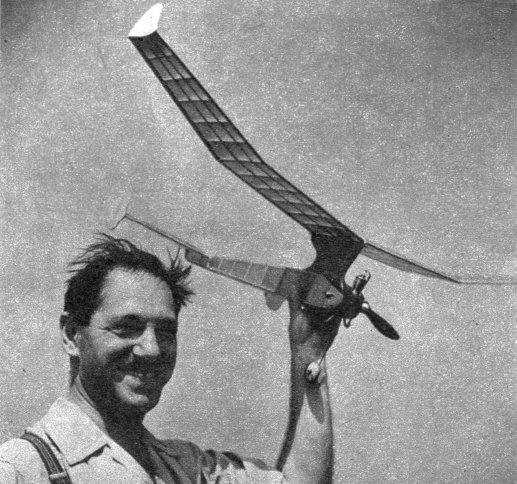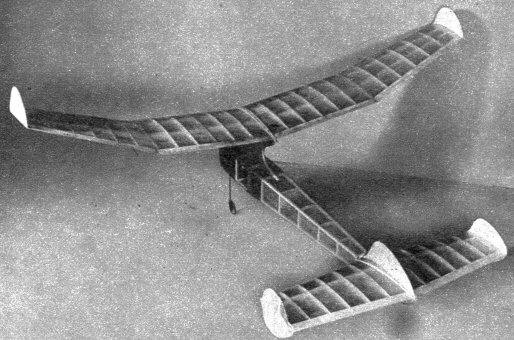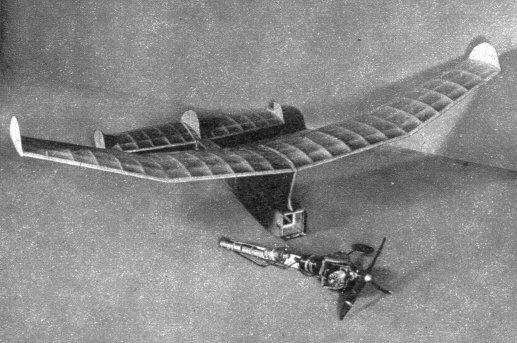|
STRATO-STREAK You don't know climb until you've built one
THE Strato-Streak was created to prove beyond all doubt that the vest-pocket gas model can compete almost on an equal basis with larger-sized contest gas models. In creating the design, full consideration was given to all existing proven features of successful gas models. The acceptable features were embodied in addition to a number of new ideas. This ship was designed for performance without any particular stress on appearance. Only the features vital to high-grade performance were incorporated. The gas-model competition rules being what they are, a fast climb is of primary importance. The model was made directionally stable so that it could point its nose to the sky and keep climbing on its tail until the motor cut. It was streamlined to the nth degree, all resistance being cut down to a minimum, so that a fast climb would be possible. To assist in this, a thin airfoil was used. When the motor cuts, the proportionately large wingspan, coupled with a short moment arm, permits tight gliding circles which are vital for taking advantage of rising currents. Construction is simplicity itself. The fuselage, composed of four longerons, is square. The wings have a straight taper, eliminating the possibility of warp. The tail is the same. The wing fins and rudder are sheet balsa, which makes for the easiest construction. The ignition unit, the source of greatest trouble with small models, is so simply arranged, that it presents no problems, even for beginners. The simplicity of this high-performance model proves conclusively the practicability of vest-pocket gas models, which can be rapidly constructed and which will give performance equal to, if not better than, models of twice or three times its size -- and the larger ships require many days of tedious labor and are costly to repair when damaged. This entire model can be built for less than a dollar. If it is properly constructed without warp, we urge extreme caution in flying it with motor runs over ten seconds. The model will consistently fly out of sight when a full twenty-second motor run is allowed. CONSTRUCTION Make the two fuselage sides one on top of the other. Note that the longerons go past the first cross brace to act as allocating stubs for the firewall. Assemble the square body. Fill in the two sides and bottom between the first and second cross brace with 3/32" sheet balsa and cover the next side station with celluloid on whichever side is more practical for you. Through this window you can watch the timer and thereby vary the motor run to your liking. Cut the plywood bulkhead carefully so that the four longeron stubs fit snugly. Give it a coat of glue. Screw on the motor mounts temporarily and then locate the landing-gear wire. If you use the built-in gas tank, put it on the side which is handier for you. Make the V-shaped ignition channel and glue it in the back of the firewall. In its correct position it is lying on one side on the bottom of the body. Wire up the ignition unit and try it. Open the ports of the engine and press the breaker points together for a split second. If the ignition is healthy, a loud click is heard in the cylinder. In case this click is heard only once in a while, the cause may be worn or dirty points, weak batteries, or fouled plugs, providing the wiring is O.K. and the coil and condenser are in good shape. Do not proceed with the rest of the plane unless your motor is running smoothly. Decide just this once that the ignition is not the last thing in the model -- but the first. Make the wing in four sections. Cover with light Silkspan. On the tip sections, cover with the grain running parallel to the ribs. This reduces the possibility of warp and makes a smoother airfoil. The elevator is made the same way. Cover all the rudders with Silkspan. FLYING If the wing is not warped, the model should hand-glide beautifully. Correct the incidence on the elevator in case it is necessary. Use a six second motor run on the first flight, with the spark advanced halfway. (About ten-o'clock position on the Atom.) The model should go to the right under power and glide to the left. The final adjustment on my models boils down to 1/16" right thrust under the firewall and 1/4" left on the tip of the rudder tab. Adjusted properly and with a hot motor, the Strato-Streak will reach an unbelievable altitude in twenty seconds and will glide with the best of them. Keep 'em streaking!
Scanned From December 1941 |
||||||||||||||||||||||||||||||||||||



